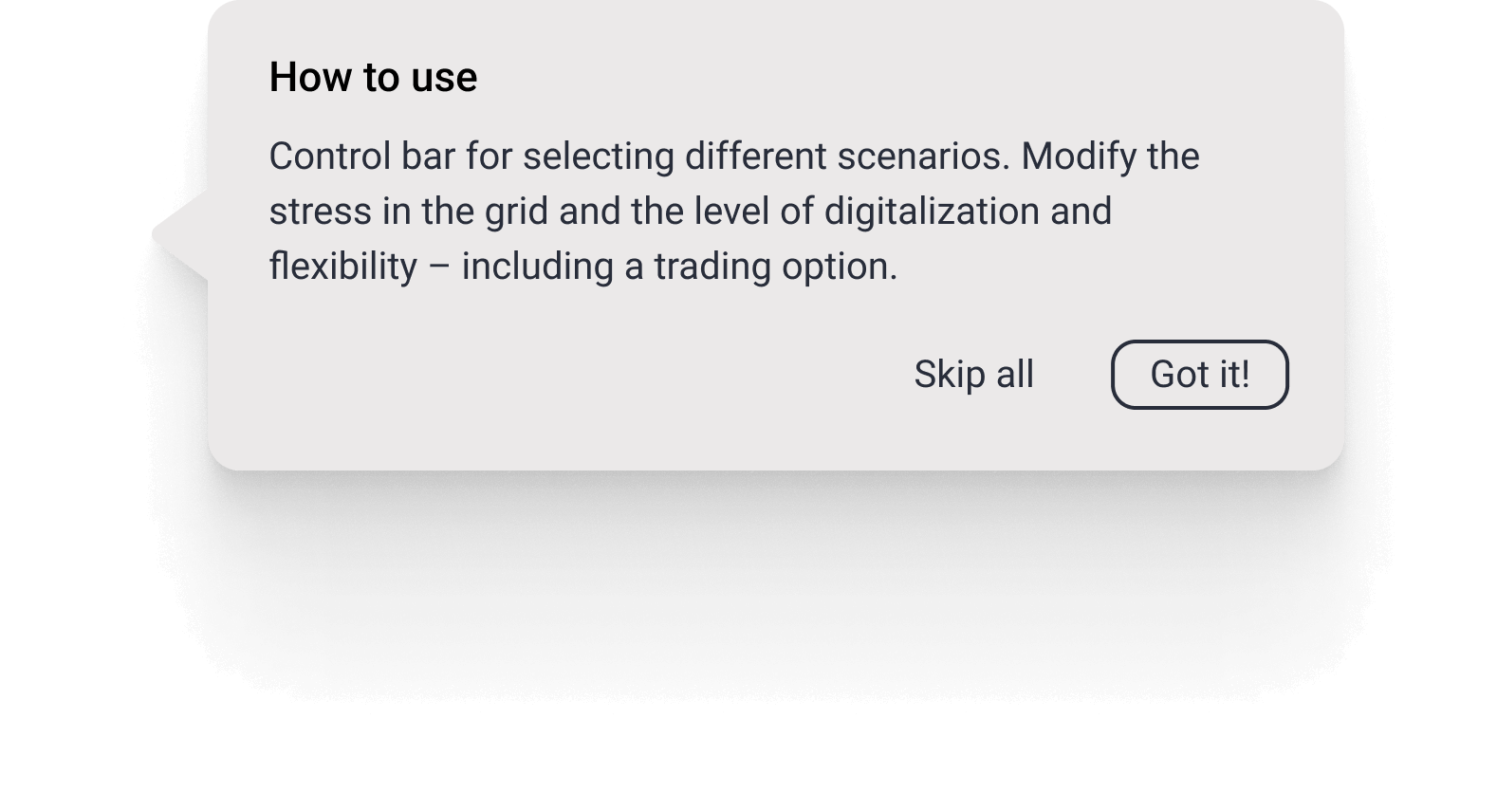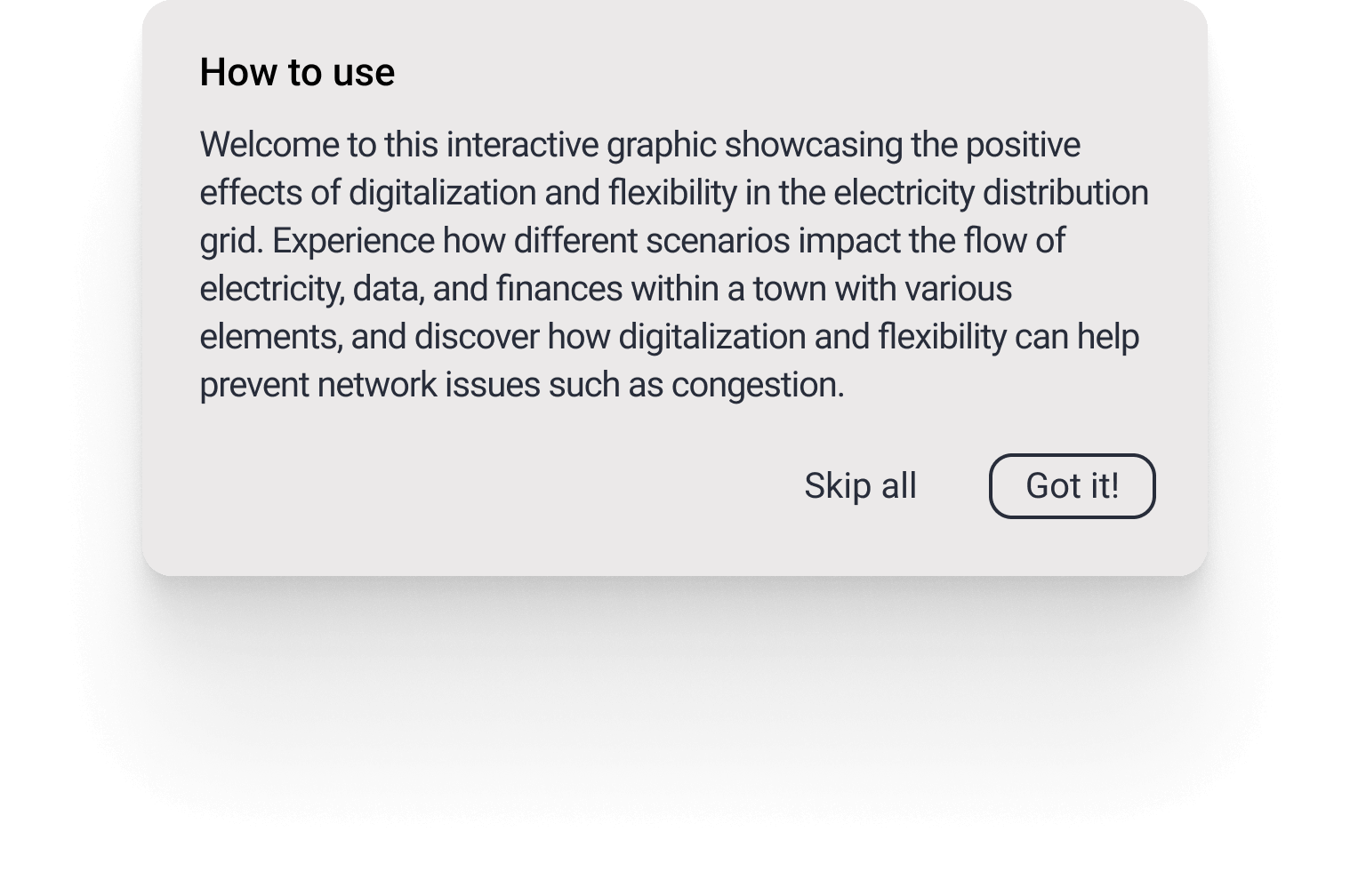

Open-Space PV
Open space PV parks generate green electricity from decentralized installations. Such PV parks can be part of Virtual Power Plants (VPPs) which create increased income by efficiently synchronizing and marketing the power generated from numerous decentralized installations. VPPs can also be effectively used to provide flexibility to the electricity grid, further optimizing the integration of renewable energy sources - and even generate additional revenue.

Brewery
The brewery acts as a large flexible consumer, adjusting its cooling processes based on electricity production and demand. When there is excess renewable electricity generation the brewery increases its cooling operations, producing ice in the ice storage for later use. Conversely, during periods of higher electricity demand, the brewery reduces its electricity demand for cooling by melting the ice in the ice storage.
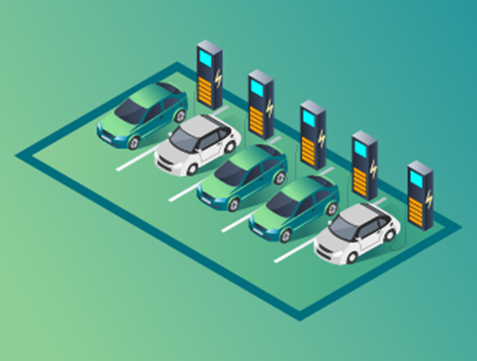
Electric Cars-Carsharing Pool
Electric vehicles contribute to sector coupling by integrating the transportation and energy sectors, facilitating the efficient use of renewable energy. They can behave grid-friendly through intelligently scheduled charging processes. They can be charged during periods of surplus electricity and-in future-discharged back into the grid during periods of peak demand, helping to reduce grid stress.
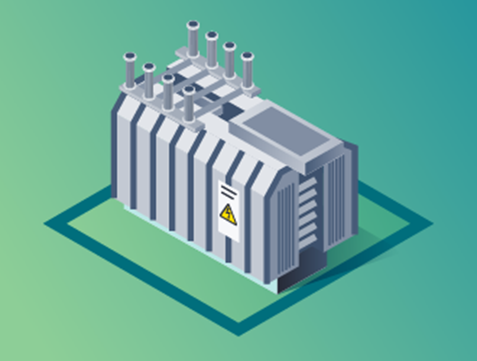
Transformer as a connection to the upstream network level
This substation adjusts the voltage level for the distribution to end-users and serves as a link between the local and upstream voltage levels of the electricity grid. While large power plants are traditionally connected to the transmission grid, renewable energy sources often are connected to the distribution grid together with a high number of loads and storage units. This shared responsibility requires a close collaboration between the transmission and distribution system operators to ensure system security.

Control Center
The Distribution System Operator (DSO) - often being a part of the local utility - operates a control center to ensure a reliable power supply by monitoring, managing, and controlling the electricity distribution network it is responsible for. Using advanced technologies and real-time data, the control center can optimize energy flow, detect and resolve grid problems such as congestion, and maintain a balance between supply and demand for efficient, stable, and reliable electricity distribution. With the increasing integration of renewable energy, efficient grid control by the DSO is becoming more and more important.
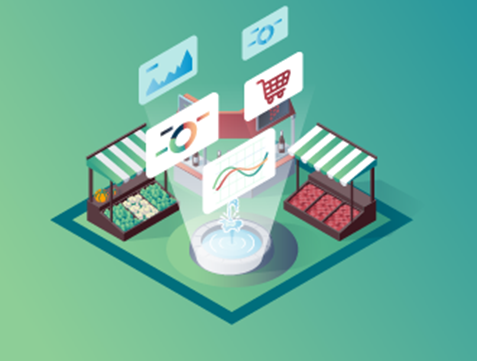
Virtual local marketplace
Once the trading option is activated, producers, prosumers, and consumers can engage in buying and selling electricity in the virtual local marketplace. Local electricity markets focus on trading within a specific geographical region, fostering community empowerment and promoting the utilization of renewable energy sources at a local level.

Normal consumer house
A standard consumer house refers to a still typical residential property that consumes electricity from the distribution network. Their energy consumption patterns affect the overall demand on the distribution grid. By adapting their demand of electricity, they can offer flexibility to the grid.
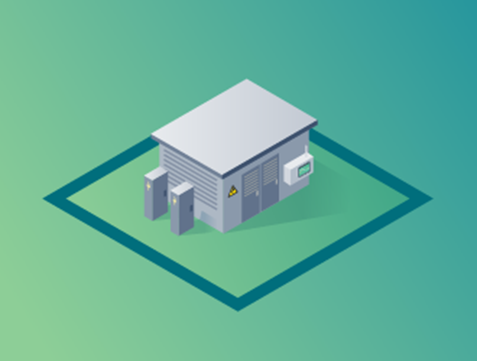
Local power transformer
A local power transformer is an essential component of the electricity distribution network that adjusts the voltage level for the local grid in order to ensure proper distribution to nearby consumers. By integrating a Phasor Measurement Unit (PMU), the transformer can be digitally monitored, enabling early detection and resolution of network problems such as congestion.
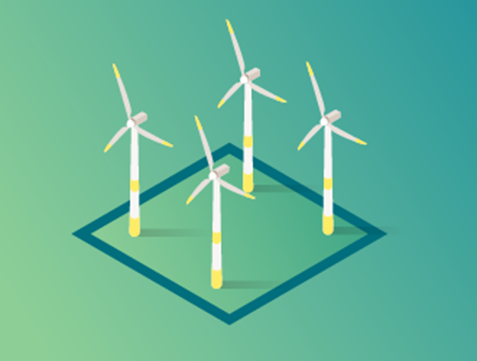
Wind Turbine
In order to avoid grid congestion, wind turbines need to be curtailed during periods of high wind. In such congestion situations, the electricity generated exceeds the capacity of the grid lines connecting it to the demand sites. Through intelligent control and increased flexibility, wind turbines can be used more efficiently and integrated seamlessly into the grid, minimizing the need for curtailment.
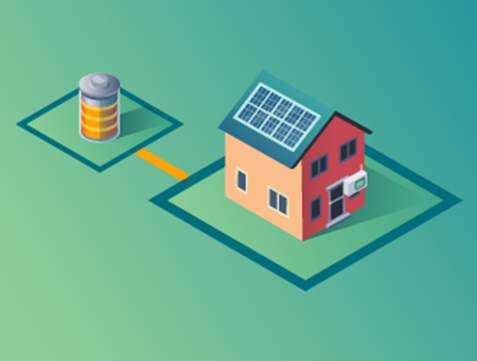
PV + Battery - House
PV installations on houses with batteries enable homeowners to generate solar energy and store excess energy for later use. This setup not only allows households to consume clean and self- generated electricity. It also benefits the electricity distribution network by reducing the strain on the grid during peak generation periods by charging the battery instead of feeding into the grid and peak demand periods by using electricity from the battery in these times.
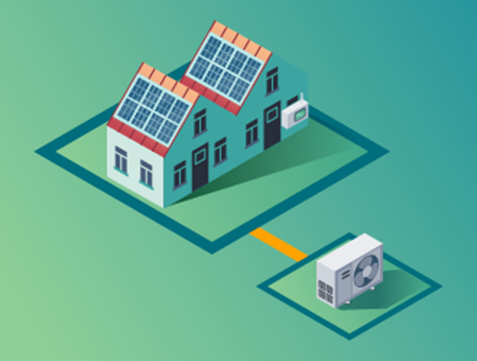
PV + heat pump + hot water tank - House
PV installations on houses combined with a heat pump can use solar energy to provide heating or cooling to the house. Together with a hot water tank, it can support the electricity distribution grid management by shifting heat production to periods of surplus renewable electricity and storing the heat in the hot water tank.

Balanced production and consumption
In this cloudy and windy scenario, electricity production and consumption are in balance. The electricity generated by the local PV panels and wind turbines together with the electricity delivered from the upstream grid cover the demand of the community. No grid issues can be observed, all electricity can be delivered to the demand sites.
Consumer and Prosumer
Residential houses and commercial consumers, such as car-sharing and a brewery, are consuming electricity. Wind turbines, open space PV and the house with PV + battery storage are producing electricity. The house with PV and heat pump is able to supply itself.

Overproduction
In this sunny and windy scenario, there is a surplus of electricity production compared to the demand. Both PV panels and wind turbines are generating a significant amount of electricity. However, this leads to congestion between the open space PV and the transformer, as well as between the wind turbines and the transformer, as the lines are too weak to transport that much electricity towards the transformer, indicated by the red electricity flow. To alleviate the congestion, some wind turbines are temporarily shut down. Money flows into the higher-level grid to partly accommodate the surplus electricity.
Consumer and Prosumer
Residential houses and commercial consumers continue to use electricity from the grid, while houses with PV panels feed-in excess electricity.

Underproduction
In this scenario, the weather is cloudy and non-windy, resulting in lower local electricity production. There is only a small amount of electricity generated from the PV panels. This leads to congestion on the lines between the higher-level grid and the consumers, which is visually represented by red flow. Despite the electricity shortage, all five cars in the car-sharing pool are charging, indicating a lack of coordination. Without digitalization, the control center lacks the necessary information to react and plan the charging according to the current grid status. In most regions of Europe, this is a hypothetical scenario as usually the grid is reinforced to be able to supply all customers even in scenarios with high demand and low local production. Still, it could theoretically happen if costly grid reinforcement is not realized in time.
To meet the demand, significant amounts of electricity need to be supplied from the higher-level grid to the region, resulting in increased money flows into the higher-level grid.
Consumers and Producers
Residential houses and commercial consumers rely on electricity from the grid, while houses with PV panels and storage systems are self-sufficient and do not need electricity from the grid.

Balanced production and consumption
In this cloudy and windy scenario, electricity production and consumption are in balance. The electricity generated by the local PV panels and wind turbines together with the electricity delivered from the upstream grid cover the demand of the community. No grid issues can be observed, all electricity can be delivered to the demand sites.
Digitalization
Smart Metering Systems are now installed everywhere, resulting in the presence of blue data flows towards the now digitized control center. The transformers are now equipped with Phasor Measurement Units (PMUs), collecting, and sending grid data to the control center, enabling early detection and resolution of grid problems such as congestion.
Car-sharing pool
The car-sharing pool now has bi-directional communication enabled with the control center, allowing for optimal charging of electric vehicles based on their specific needs. Three out of the five electric cars may soon be needed, so they are being charged, while the remaining two can are used to shift their charging times to periods of surplus electricity.
Consumers and Prosumers
PV panels and wind turbines generate electricity, with the wind turbines contributing more due to the high wind conditions. Residential houses and commercial consumers use electricity from the grid, while the house with PV + battery storage feed some electricity into the grid and receive remuneration. The house with PV,heat pump and hot water tank utilizes the self-generated electricity, which is sufficient at that time.

Overproduction
In this sunny and windy scenario, electricity production exceeds the consumption. Both PV panels and wind turbines are generating a significant amount of electricity. However, this leads to congestion between the open space PV and the transformer, as well as between the wind turbines and the transformer, as the lines are too weak to transport that much electricity towards the transformer, indicated by the red electricity flow. To alleviate the congestion, some wind turbines are temporarily shut down.
Digitalization
Smart Metering Systems are now installed everywhere, resulting in the presence of blue data flows towards the now digitized control center. The transformers are now equipped with Phasor Measurement Units (PMUs), collecting, and sending grid data to the control center, enabling early detection and resolution of grid problems such as congestion.
Car-sharing pool
The car-sharing pool has bi-directional communication enabled with the control center, allowing optimal charging of electric vehicles based on their individual needs. In this case, all five electric cars are charged at full power to locally use the excess electricity generated and support grid operation.
Consumer and Prosumer
Residential houses and commercial consumers use electricity from the grid, while houses with PV panels also export electricity and charge their batteries.
Outcome
Despite these improvements, the wind turbines still require curtailment. Also, money flows into the higher-level grid to accommodate the surplus electricity. Now explore if the use of Flexibility Management helps addressing these issues!

Underproduction
In this cloudy and non-windy scenario, electricity consumption exceeds the local generation. Only a small amount of electricity is generated by the PV panels. As a result, there is a congestion on the lines between the upstream grid level and the consumers, as indicated by the red electricity flow.
Digitalization
Smart Metering Systems are now installed everywhere, resulting in the presence of blue data flows towards the now digitized control center. The transformers are now equipped with Phasor Measurement Units (PMUs), collecting, and sending grid data to the control center, enabling early detection and resolution of grid problems such as congestion.
Car-sharing pool
The car-sharing pool has bi-directional communication enabled with the control center, allowing for intelligent charging of electric vehicles. In this case, only one car is charged to alleviate the electricity shortage.
Consumer and Prosumer
Residential houses and commercial consumers use electricity from the grid and pay for it. Houses with PV panels are self-sufficient and do not rely on electricity from the grid.
Outcome
Money flows into the higher-level grid, as electricity must be supplied from the central grid to meet the local demand. It seems that digitalization is not enough to help the system overcome its grid issues. It is worth trying to see if Flexibility Management can help to solve the problems!

Balanced production and consumption
In this cloudy and windy scenario, electricity production and consumption are in balance. The electricity generated by the local PV panels and wind turbines together with the electricity delivered from the upstream grid cover the demand of the community. No grid issues can be observed, all electricity can be delivered to the demand sites and no flexibility measures are needed.
Digitalization
Smart Metering Systems are installed everywhere, resulting in the presence of blue data flows towards the now fully digitized control center. The transformers are equipped with Phasor Measurement Units (PMUs), collecting, and sending grid data to the control center, enabling early detection and resolution of grid problems such as congestion. Prosumers and Consumers are now as well equipped with Home respectively Factory Energy Management Systems which enable both observability and, if necessary, receiving and responding to flexibility demands sent by the control center of the utility.
Car-sharing pool
The car-sharing pool has bi-directional communication enabled with the control center, allowing for optimal charging of electric vehicles based on their specific needs. Three out of the five electric cars may soon be needed, so they are being charged, while the remaining two can shift their charging times to periods of surplus local electricity generation.
Consumers and Prosumers
PV panels and wind turbines continue to generate electricity, with the wind turbines contributing more due to the high wind conditions. Residential houses and commercial consumers use electricity from the grid, while the house with PV + battery storage feeds some electricity into the grid and receives remuneration. The house with PV and a heat pump utilizes the self-generated electricity, which is sufficient at that time.

Overproduction
In this sunny and windy scenario, electricity production exceeds the consumption. Both, PV panels and wind turbines are generating a significant amount of electricity. As opposed to scenarios without digitization and flexibility management, adaptation of demand is possible to use all locally generated electricity and prevent any congestions in the local grid.
Digitalization
Smart Metering Systems are installed everywhere, resulting in the presence of blue data flows towards the now fully digitized control center. The transformers are equipped with Phasor Measurement Units (PMUs), collecting, and sending grid data to the control center, enabling early detection and resolution of grid problems such as congestion. Prosumers and Consumers are now as well equipped with Home respectively Factory Energy Management Systems which enable both observability and, if necessary, receiving and responding to flexibility demands sent by the control center of the utility.
Car-sharing pool
The car-sharing pool has bi-directional communication enabled with the control center, allowing optimal charging of electric vehicles based on their individual needs. In this case, all five electric cars are charged at full power to absorb the excess locally generated electricity.
Consumer and Prosumer
With the now installed Energy Management Systems both in residential houses and commercial consumers, they received the signal from the control center to increase their consumption and use as much electricity from the grid as possible. So, houses with PV panels charge their batteries or generate heat to store in their heat storage. The commercial consumer, the brewery, runs its ice production at maximum to consume as much electricity as possible, creating ice in their ice storage for later use.
Outcome
The now available Energy Management options at all prosumers and consumers in addition to observability enables a local balancing of generation and demand by increasing the demand in times of high generation. As this increased electricity demand is asked for by the utility, prosumers and consumers with increased demand get remunerated for their grid-beneficial behavior. Curtailment of local PV and wind generation is no longer necessary.

Underproduction
In this cloudy and non-windy scenario, electricity consumption exceeds the local generation. Only a small amount of electricity is generated by the PV panels. As opposed to scenarios without digitization and flexibility management, adaptation of demand is possible to compensate for a shortage in electricity production.
Digitalization
Smart Metering Systems are installed everywhere, resulting in the presence of blue data flows towards the now fully digitized control center. The transformers are equipped with Phasor Measurement Units (PMUs), collecting, and sending grid data to the control center, enabling early detection and resolution of grid problems such as congestion. Prosumers and Consumers are now as well equipped with Home respectively Factory Energy Management Systems which enable both observability and, if necessary, receiving and responding to flexibility demands sent by the control center of the utility.
Car-sharing pool
Additionally, the car-sharing pool has bi-directional communication enabled with the control center, allowing for intelligent charging of electric vehicles. In this case, one car is charged to alleviate the electricity shortage.
Consumer and Prosumer
Residential houses and commercial consumers use electricity from the grid and pay for it. Houses with PV panels are self-sufficient and do not rely on the grid for electricity supply. With the now installed Energy Management Systems both in residential houses and commercial consumers, they receive the signal from the control center to reduce their consumption of electricity from the grid as much as possible. So, houses with PV + battery storage feed-in to the grid. The commercial consumer, the brewery, uses the earlier produced ice from the ice storage instead of just- in-time cold production from electricity.
Outcome
The now available Energy Management options at all prosumers and consumers in addition to observability enables a local balancing of generation and demand by reducing the demand in times of low local generation. Prosumers and consumers with reduced demand get remunerated for their grid-beneficial behavior. Less electricity from the upstream grid is needed and subsequently less money flows from the local community.

Balanced production and consumption
In this cloudy and windy scenario, electricity production and consumption are in balance. The electricity generated by the local PV panels and wind turbines together with the electricity delivered from the upstream grid cover the demand of the community. No grid issues can be observed, all electricity can be delivered to the demand sites and no flexibility measures are needed.
The option for local trading is now activated. In comparison to the scenario "Balanced with Flexibility Management, but no trading”, the only difference here lies in the monetary flow, while the electricity and data flows remain the same.
Digitalization
Smart Metering Systems are installed everywhere, resulting in the presence of blue data flows towards the now fully digitized control center. The transformers are equipped with Phasor Measurement Units (PMUs), collecting, and sending grid data to the control center, enabling early detection and resolution of grid problems such as congestion. Prosumers and Consumers are now as well equipped with Home respectively Factory Energy Management Systems which enables both observability and, if necessary, receiving and responding to flexibility demands sent by the control center of the utility.
Car-sharing pool
The car-sharing pool has bi-directional communication enabled with the control center, allowing for optimal charging of electric vehicles based on their specific needs. Three out of the five electric cars may soon be needed, so they are being charged, while the remaining two can shift their charging times to periods of surplus electricity.
Consumers and Prosumers
PV panels and wind turbines continue to generate electricity, with the wind turbines contributing more due to the high wind conditions. Residential houses and commercial consumers use electricity from the grid, while the house with PV + battery storage feeds some electricity into the grid and receives remuneration. The house with PV and a heat pump utilizes the self-generated electricity which is sufficient at that time.
Local Trading
Two local trading options are now available (Peer-to-Peer Trading and Local Virtual Marketplace), allowing producers, prosumers and consumers to locally buy and sell their electricity.
The Peer-To-Peer Trading enables prosumers to sell their surplus electricity directly to their neighbors, as shown by the money flow between the PV + battery storage house and the normal consumer household.
The Local Virtual Marketplace facilitates direct trading between producers, consumers and prosumers, reducing dependence on large energy corporations. This approach strengthens the local community and supports a decentralized energy supply.
Additionally, dynamic pricing mechanism allows for real-time adjustment of electricity prices, which encourages consumers and prosumers to align their energy needs with market conditions and promotes efficient energy utilization.

Overproduction
In this sunny and windy scenario, electricity production exceeds the consumption. Both, PV panels and wind turbines are generating a significant amount of electricity. As opposed to scenarios without digitization and flexibility management, adaptation of demand is possible to use all locally generated electricity and prevent any congestions in the local grid.
The option for local trading is now activated. In comparison to the scenario "Overproduction with Flexibility Management, but no trading”, the only difference here lies in the monetary flow, while the electricity and data flows remain the same.
Digitalization
Smart Metering Systems are installed everywhere, resulting in the presence of blue data flows towards the now fully digitized control center. The transformers are equipped with Phasor Measurement Units (PMUs), collecting, and sending grid data to the control center, enabling early detection and resolution of grid problems such as congestion. Prosumers and Consumers are now as well equipped with Home respectively Factory Energy Management Systems which enables both observability and, if necessary, receiving and responding to flexibility demands sent by the control center of the utility.
Car-sharing pool
The car-sharing pool has bi-directional communication enabled with the control center, allowing optimal charging of electric vehicles based on their individual needs. In this case, all five electric cars are charged at full power to absorb the excess locally generated electricity.
Consumer and Prosumer
With the now installed Energy Management Systems both in residential houses and commercial consumers, they received the signal from the control center to increase their consumption and use as much electricity from the grid as possible. So, houses with PV panels charge their batteries or generate heat to store in their heat storage. The commercial consumer, the brewery, runs its ice production at maximum to consume as much electricity as possible, creating ice in their ice storage for later use.
Local Trading
Two local trading options are now available (Peer-to-Peer Trading and Local Virtual Marketplace), allowing producers, prosumers and consumers to locally buy and sell their electricity.
The Peer-To-Peer Trading enables prosumers to sell their surplus electricity directly to their neighbors, as shown by the money flow between the PV + battery storage house and the normal consumer household.
The Local Virtual Marketplace facilitates direct trading between producers, consumers and prosumers, reducing dependence on large energy corporations. This approach strengthens the local community and supports a decentralized energy supply.
Additionally, dynamic pricing mechanism allows for real-time adjustment of electricity prices, which encourages consumers and prosumers to align their energy needs with market conditions.
Outcome
The now available Energy Management options at all prosumers and consumers in addition to observability enables a local balancing of generation and demand by increasing the demand in times of high generation. As this increased electricity demand is asked for by the utility, prosumers and consumers with increased demand get remunerated for their grid-beneficial behavior. Curtailment of local PV and wind generation is no longer necessary.
The local trading options allow the customers to access locally generated renewable electricity, promoting sustainability and reducing dependence on non-renewable sources.

Underproduction
In this cloudy and non-windy scenario, electricity consumption exceeds the local generation. Only a small amount of electricity is generated by the PV panels. As opposed to scenarios without digitization and flexibility management, adaptation of demand is possible to balance out a shortage in electricity production.
The option for local trading is now activated. In comparison to the scenario "Underproduction with Flexibility Management, but no trading”, the only difference here lies in the monetary flow, while the electricity and data flows remain the same.
Digitalization
Smart Metering Systems are installed everywhere, resulting in the presence of blue data flows towards the now fully digitized control center. The transformers are equipped with Phasor Measurement Units (PMUs), collecting, and sending grid data to the control center, enabling early detection and resolution of grid problems such as congestion. Prosumers and Consumers are now as well equipped with Home respectively Factory Energy Management Systems which enables both observability and, if necessary, receiving and responding to flexibility demands sent by the control center of the utility.
Car-sharing pool
Additionally, the car-sharing pool has bi-directional communication enabled with the control center, allowing for intelligent charging of electric vehicles. In this case, one car is charged to alleviate the electricity shortage.
Consumer and Prosumer
Residential houses and commercial consumers use electricity from the grid and pay for it. Houses with PV panels are self-sufficient and do not rely on the grid for electricity. With the now installed Energy Management Systems both in residential houses and commercial consumers, they receive the signal from the control center to reduce their consumption of electricity from the grid as much as possible. So, houses with PV + battery storage feed-in to the grid. The commercial consumer, the brewery, uses the earlier produced ice from the ice storage instead of just- in-time cold production from electricity.
Local Trading
Local trading options are now available (Peer-to-Peer Trading and Local Virtual Marketplace), allowing producers, prosumers and consumers to buy and sell their electricity locally.
The Peer-To-Peer Trading enables prosumers to sell their surplus electricity directly to their neighbors. However, as little electricity is produced in this scenario, the house with the PV + battery storage cannot sell electricity to its neighbors.
The Local Virtual Marketplace facilitates direct trading between producers, consumers and prosumers, reducing dependence on large energy corporations. This approach strengthens the local community and supports a decentralized energy supply.
Additionally, dynamic pricing mechanism allows for real-time adjustment of electricity prices, which encourages consumers and prosumers to adapt their energy needs to market conditions.
Outcome
The now available Energy Management options at all prosumers and consumers in addition to observability enables a local balancing of generation and demand by reducing the demand in times of low local generation. Prosumers and consumers with reduced demand get remunerated for their grid-beneficial behavior. Less electricity from the upstream grid is needed and subsequently less money flows from the local community.
The local trading options allow the customers to access locally generated renewable electricity, promoting sustainability and reducing dependence on non-renewable sources.






